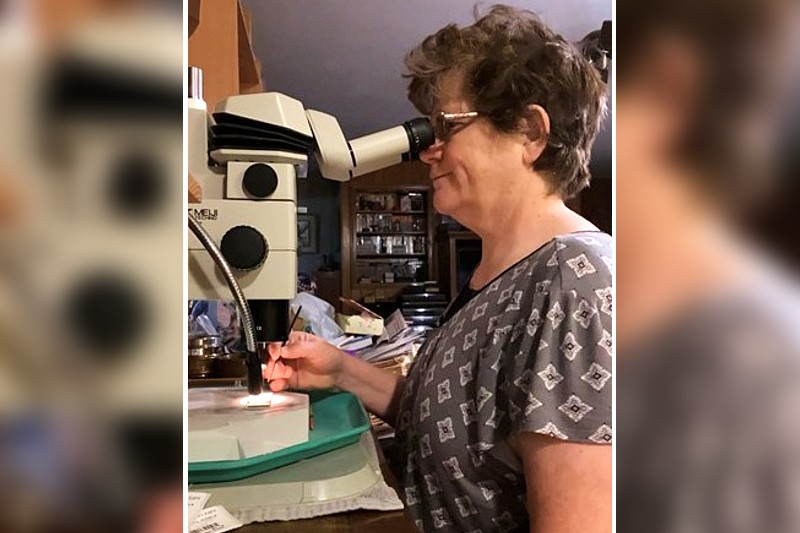Breadcrumb
New Research by UCM Professor Demonstrates Impact of Sediment, Meltwater on Glacier Movement
By Jeff Murphy, May 13, 2020

WARRENSBURG, MO – When discussing the impact of global warming, many skeptics often
cite examples of glaciers that aren’t retreating as a way to support a belief that
human-induced climate change doesn’t exist. Recently published research involving
a University of Central Missouri professor, however, shows that new models depicting
the long-term nature of glacial movement can demonstrate the pitfalls of making such
an assumption.
That is the view of Dr. Sally Zellers, professor of geoscience in the School of Geoscience,
Science and Safety at UCM. She is the second author on a research article led by Dr.
Ellen Cowan, a professor at Appalachian State University, published in April 2020
by “Nature Communications.” Ten other researchers who were part of the International
Ocean Discovery Program (IODP) contributed to the article titled, “Sediment controls
dynamic behavior of a Cordilleran Ice Stream at the Last Glacial Maximum.”
“A lot of times, people who argue against the idea of climate change caused by humans
will point to a glacier that is actually advancing rather than retreating,” Zellers
said. She noted that some individuals believe an advancing glacier is a sign that
warming temperatures caused by greenhouse gases aren’t affecting these large icy masses.
“What they don’t realize when they are doing that is that this particular glacier
is responding to local controls or processes rather than global. But in the end, the
global processes will take over,” she said.
Research that contributed to the article started in 2013, and involved a number of
scientists who spent about two months in the Gulf of Alaska, in part, studying glacial
marine sedimentology for IODP’s expedition No. 341. IODP is an international marine
research collaboration which uses ocean-going research platforms such as drill ships
to explore the Earth's history and dynamics. Their work creates data that is generated
from seafloor sediments and rocks in addition to monitoring sub-seafloor environments.
Scientists from around the world are selected for IODP expeditions, where they may
work shipboard, or in the case of Zellers, conduct shore-based research.
The study utilized long core samples to look at the Bering Glacier from the perspective
of the sediment that gets transported out to sea by icebergs through a process called
“ice rafting.” Zellers’ research focused on looking at foraminifora (forams), which
are microscopic single-celled organisms that live in the water or in the sediments.
They die and they accumulate and researchers can look at the diversity of these different
creatures and gain insight into the paleoenvironmental conditions, she said. Researchers
gain information about the history of the location, including helping to determine
where the edge of a glacier was at a particular point in time.
“If the glacier was close to the site, there was a lot of meltwater production. If
the glacier was closer to shore, then a different grouping of these fossils would
exist, and that would tell us something about the oceanography of the site,” Zellers
said.
“So that’s how we kind of started out. We (Zellers and Cowan) were both looking at
the same column of mud and asking different questions, then we realized what we were
looking at was kind of lock step related. I got different assemblages of the fossils
when the ice rafting was abundant. And I got different assemblages when there was
no ice rafting, and then there were times when this particular area was ice free but
also when the ocean conditions had less oxygen (we call this the oxygen minimum zone).”
From the core samples, the researchers learned more about how glaciers respond to
different environmental changes over time.
According to Zellers, “Glaciers are kind of like bulldozers. They are moving downhill
slowly. They have the ability to cut into bedrock, and some of that bedrock gets broken
up into small bits of sediment. Then the glacier moves that sediment downhill due
to gravity to its end, its terminus.”
“This particular type of glacier is called a ‘temperate glacier’ because it is not
in a polar climate but in a warmer climate. So in a polar glacier, the glacier is
literally frozen to the bedrock, but in this kind of glacier, it (temperate glacier)
is actually moving on a sheet of water at its base. So there’s a lot of meltwater
at the base, and all that meltwater has sediment in it. The sediment is delivered
at the terminus.”
Zellers said the combination of meltwater and deposits of sediment piling up comprise
the local processes that contribute to stopping the glacier from advancing – at least
temporarily.
“I think that is the message our paper brings. It is simply that at times in the history
of a glacier the local processes will control the behavior of the glacier. But in
the end, the glacier will not handle atmospheric warming,” she remarked. “That’s what
we’re documenting. This glacier stopped responding to its local processes and ended
up retreating to where it is now, which is on land and not extending out onto the
continental shelf.”
“That is the summary,” Zellers said. “Local processes can control the behavior of
the glacier and need to be considered when looking at modeling the long-term behavior
of glaciers.”
Zellers, who has been on the UCM faculty since 2003, plans to continue her work with IODP in 2021. This time, however, she will travel to Japan to conduct research related to earthquakes and tsunamis. To read the recent research article in “Nature Communications,” go to https://rdcu.be/b3y88.








